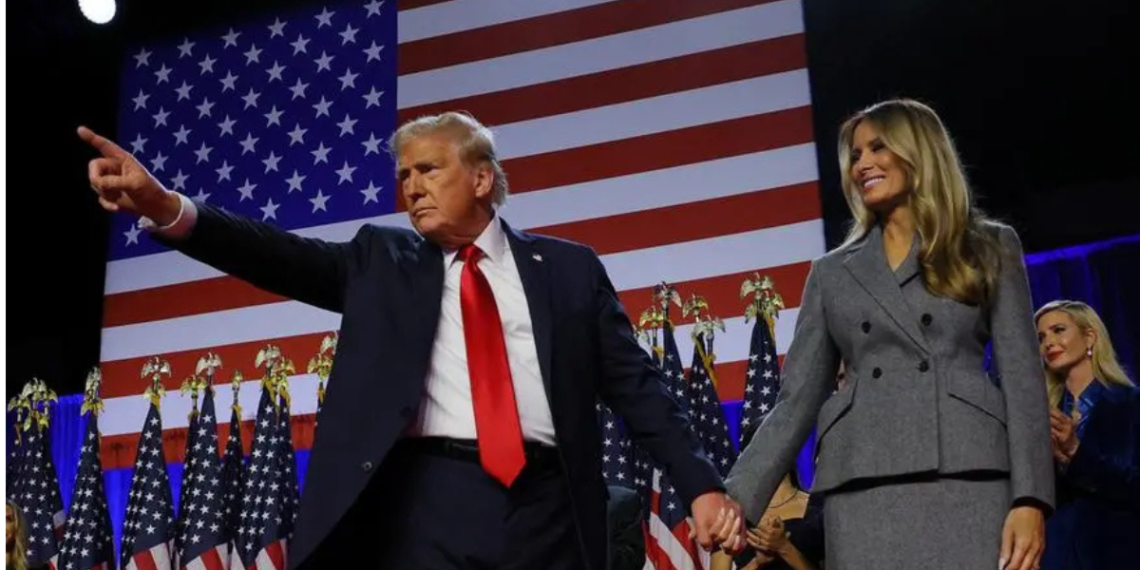Analysts attribute Trump’s success to a strategic mix of factors: carefully built alliances, public sympathy following assassination attempts, a highly targeted PR campaign, perceived weaknesses in Harris’s campaign, and a strong position against “woke” politics.
By Navin Upadhyay
In a decisive victory, Donald Trump has clinched the U.S. presidency, winning over swing states and securing the 270 electoral votes needed to reclaim the White House. With 224 electoral votes, his rival Kamala Harris fell short as major media outlets declared Trump the winner. This landmark election now makes Trump only the second Republican in two decades to serve a second term, following George Bush’s presidency from 2001 to 2009.
Also Read: Victory and Vision: Trump’s Rousing Speech Sets New Course for USA
The fiercely polarizing election season included two assassination attempts on Trump, adding to the high-stakes atmosphere. His path to victory ran through pivotal states, with confirmed wins in Georgia and North Carolina and leads in Pennsylvania, Arizona, Michigan, Wisconsin, and Nevada. Confident from the start, Trump had hinted he would only accept the results if he deemed the election process fair, expressing ongoing concerns over electronic voting machines. After casting his vote in Florida, he asserted his confidence in securing a second term in what may be one of the most contentious elections in recent history.
A Campaign on the Edge: The Strategy Behind Trump’s Win
With a laser focus on immigration, economic growth, and cultural issues, Trump’s campaign resonated deeply with voters. While his style—bold, controversial, and unapologetically brash—polarized the nation, it also captured the attention of millions. Voters rallied behind his promises to reinvigorate the economy, restrict immigration at the Southern border, and champion his signature “Make America Great Again” message. Trump also drew the support of religious voters by calling out the Democrats’ backing of transgender rights, adding a socially conservative appeal that resonated across party lines.
US Election Results LIVE: The Unexpected Voter Shifts that Powered Trump’s Victory
Analysts point to a complex blend of factors driving Trump’s success: strategic alliances, sympathy following assassination attempts, a meticulously targeted PR strategy, perceived vulnerabilities in Harris’s campaign, and a strong stance against “woke” politics.
But perhaps most surprising were the subtle shifts within the Democratic coalition itself. Black, Latino, and young voters—a steadfast base for Democrats—showed signs of softening support. Preliminary data from AP VoteCast, a survey of over 115,000 voters, revealed that while Harris retained the majority among these groups, Trump made inroads, particularly with Black voters, potentially fracturing the foundation of the Democratic coalition.
Breaking Down the Numbers: What Changed?
Early data suggests that Trump’s approach, which blended traditional Republican values with anti-establishment rhetoric, resonated with a broader swath of voters than anticipated. By capitalizing on economic concerns and cultural debates, Trump attracted significant numbers of Black and Latino voters, tipping the scales in crucial battleground states.
The Legacy of 2024: A Divided Nation, an Unyielding Campaign
As the dust settles, Trump’s victory in the 2024 election will likely go down in history not only for its intensity but for reshaping the American political landscape. With shifts across voter demographics and a message that echoed through every corner of the country, Trump has proven that the path to victory lies not only in winning over swing states but in capturing the hearts of those long considered unreachable.













